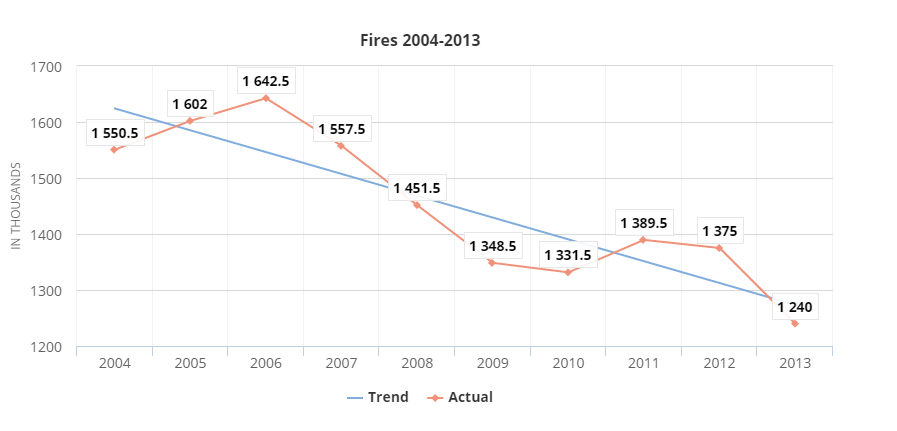Introduction: A General Concept of Fire Safety
Although the concept of fire safety might seem self-explanatory to an adult, young students need to be taught essential rules on the subject so that they should not expose themselves to the related dangers.
Furthermore, maintaining fire safety is a challenging task that requires certain knowledge and skills. Consequently, it is important to make sure that the students learn the essential guidelines; thus, in case of a fire threat, they will be capable of identifying the right course of action and keeping themselves and others safe.
Rationale: Keeping the Students Safe
It should be noted that the recent fire statistics provided by the U.S. Fire Administration does not provide many reasons for concern. In fact, according to the latest data, the number of fires has dropped rapidly since 2012, as Fig 1 shows (U.S. Fire Administration, 2016).

Nevertheless, the school fire statistics show that the percentage of school fires remains dangerously consistent (Satterly, 2014). Middle- and high-schoolers are exposed to the danger of experiencing the problem to the greatest degree, the U.S. Fire Administration (2016) says. Even though the risk of a fatality due to a school fire is considered to be rare, as a recent report states (Satterly, 2014), there is a strong need to provide the learners with the information that will help them reduce the risks to the minimum.
Term and Length: Done in 20 Hours
It is expected that the program will require 10 hours (4 lectures, each 1 hour long, 6 practical tasks, each taking 20 minutes, and 8 training sessions, each 30 minutes long).
Term Benefits: Safe and Sound
The short-term benefit is that the students will receive essential information on fire safety. The long-term benefit is that the learners will acquire skills necessary to address any threat to their life in a careful and efficient manner.
Program Goals: Equipping Participants with Essential Knowledge
Fire safety is one of the areas that are likely to evolve together with technological progress. While there are basic rules that cannot change with time, certain additions are likely to emerge with the progress of technology and other relevant areas. Therefore, promoting the idea of caution and compliance with the existing rules of fire safety can be viewed as the primary goals of the project.
Furthermore, the project may also be aimed at helping learners become more responsible. As soon as the participants realize that their safety, as well as the safety of others, hinges on their actions and choices, the students are likely to approach the issue in question with more thought. Put differently, the project will serve as the means of changing the learners’ attitude toward their physical and emotional wellbeing, thus, promoting a more responsible approach.
Organization of Grades: How to Avoid Discouragement
When it comes to fire safety, it is the teacher’s primary responsibility to make sure that each of the students has learned the necessary information and acquired the corresponding skills. Therefore, an assessment of the learners’ progress is crucial. However, the instructor must also bear in mind that harsh evaluation is likely to discourage students from learning more about the subject matter. Therefore, it will be necessary to design the grading system that will point to the areas in which the students have succeeded, as well as those that they will have to work on. Furthermore, it will be desirable to abstain from labeling the low grades as “fail,” “unsatisfactory,” etc. Instead, grades such as “need improvement” could be suggested.
Topics to Be Covered: Outline
In order to promote safety among learners, one will have to consider the following topics to cover:
Fire prevention
Definition of fire
Before going any further, the learners will have to know how to detect fire.
Causes of fire
The learners will be provided with an extensive list of the factors that may cause a fire. As a result, a more cautious behavior will be fostered among the students.
Fire causes prevention
The students will understand how to avoid creating premises for fire to erupt.
Fire mitigation
The learners will be provided with information about the actions to be taken if the fire starts.
Emergency preparedness
Preparing for a fire emergency
The students will be provided with guidelines on how to act in case of fire.
Fire emergency drills
The students will participate in drills on a regular (once a week) basis.
Evacuation procedures
The students will learn about the safe ways of exiting a building in case of fire.
Protection systems
The students will learn how to maintain fire protection systems working. Thus, they will be able to spot an emergent problem before it is too late.
Using extinguishers
The learners will be offered basic information on the types of extinguishers and how to use them.
Special Events: Outline
Apart from regular drills, the students will also have to take an exam, during which they will be provided with a fire-related scenario and demonstrate their skills of addressing the problem:
- Receiving a task;
- Determining the course of actions;
- Acting using the props provided by the instructor.
Plan for Sustaining the Program
It is essential to update the program consistently so that the students should acquire new pieces of information every year. Therefore, it will be necessary to include information about:
- Managing fire-related situations at school;
- Managing fire-related situations at home;
- Managing fire-related situations outside;
- Addressing technology-related fire threats.
The latter area is bound to be upgraded every year due to the rapid pace of technological progress.
Reference List
Satterly, S. C. (2014). Report of relative risks of death in U.S. K-12 schools. Web.
U.S. Fire Administration. (2016). U. S. fire statistics. Web.